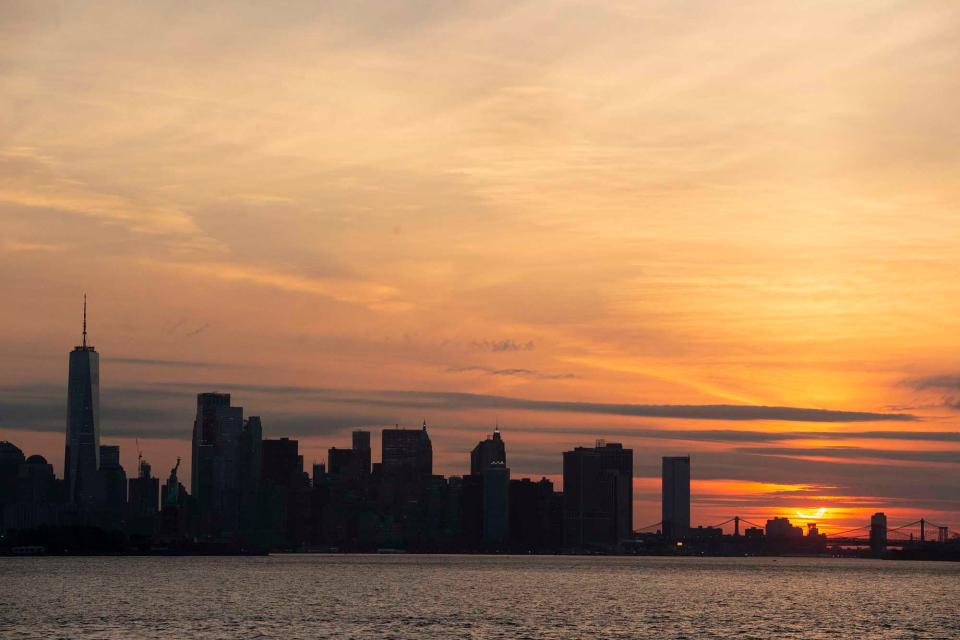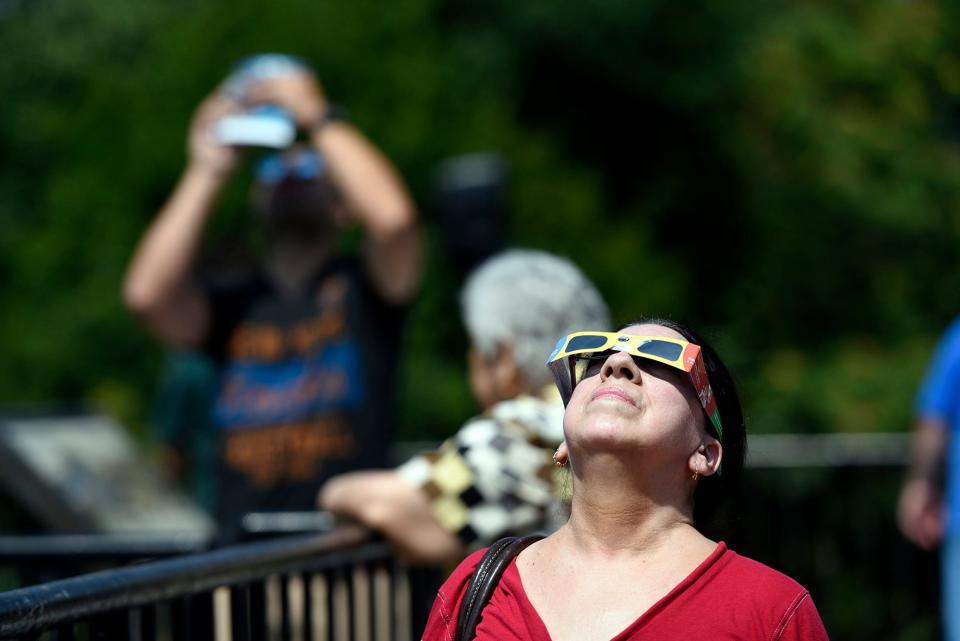NJ's next total solar eclipse is in 2079. But these other eclipses are coming soon
Depending on the weather, North Jersey could get a great show from the much-anticipated solar eclipse on April 8, with all but a sliver of the sun covered by the moon at its peak.
But for us, it won’t be a total solar eclipse.
Total solar eclipses are rare when measured against a human lifespan.
The last total solar eclipse for North Jersey took place on Jan. 24, 1925. Calvin Coolidge was president. Quackenbush Co. in Paterson was advertising women’s Oxford pumps for $1.88.
The next total solar eclipse won’t occur until May 1, 2079 — 154 years after the last one. And it will be tricky to see.
Story continues after photo gallery
The sun will rise at 5:54 a.m., with the eclipse already underway. The maximum eclipse will occur just 12 minutes after sunrise, at 6:06 a.m. The eclipse will end at 6:55 a.m.
So — if you’re lucky enough to still be alive in 2079 — you’d need to get up very early that day and find a hill or the roof of a building to watch from since the sun will be just above the horizon when the eclipse peaks.
But don’t think you have to wait until 2079 for some celestial entertainment over North Jersey skies. There are plenty of other partial solar eclipses — as well as total and partial lunar eclipses — that North Jersey will experience over the next two decades. We’ll get to those in a minute.
Solar eclipse: Think the solar eclipse is thrilling? To our ancestors, it was terrifying
A throng watched in Little Ferry
If the 1925 total eclipse is any indication, the 2079 version should engender plenty of excitement in North Jersey.
Jan. 24, 1925 offered North Jersey viewers perfect weather when the eclipse hit max at 9:11 a.m.
In Little Ferry, “a throng” watched the eclipse from porches and roofs, taking advantage of “the opportunity of a lifetime,” the Bergen Evening Record reported. Some burst into cheers.
“Contrary to previous rumors,” the paper noted, “no disorder was reported.” To make sure, the local bank took extra precautions “to prevent a robbery during the darkness.”
One resident “declared the moon was traveling opposite to its usual path,” the paper reported, while another said “that was merely an optical illusion.”

“The whole thing was electrically controlled,” explained another.
“Isn’t it great,” still another asserted, “how they know the exact minute when it will take place in spite of the years that elapse in between. How is it you can never tell when a train is going to arrive and these things in the sky seem never to fail?”
Confusion over the moon in Hackensack
In Hackensack, as the eclipse progressed, one spectator said that he couldn’t see the moon. His companion said that was because it was behind the sun. “A lengthy argument ensued,” the paper reported.
At 9 a.m., as the twilight deepened, the Hackensack streetlights went on. The tops of buildings along Main Street were lined with spectators, and amateur photographers were set up with their cameras.
At the peak of the eclipse, it was nearly as dark as midnight in Hackensack, and Mercury, Jupiter and Venus were seen clearly.

In Leonia, a retiree named J. Ernest G. Yalden, an avid astronomer, “succeeded in taking some very fine photographs from his observatory.” He had designed and built a camera specifically for the purpose, and the pictures showed the sun "with remarkable clearness.”
Andrew Jackson DeVoe, one of Hackensack’s “most distinctive and most familiar characters,” did not fare as well. DeVoe, a self-proclaimed meteorologist whose fame grew because he correctly predicted the great blizzard of 1888, said the weather would be so cloudy and misty on the day of the eclipse that nobody in North Jersey would be able to see it.
The weather was gorgeous.
Even worse for him, DeVoe was too ill to see the eclipse himself, and he died the next day. A story in the Bergen Evening Record reporting his demise was headlined, “Failed to see most interesting thing in his long career.”

All the seats on the left side of each car of that morning’s 8:55 a.m. train to New York out of Demarest were filled early “with every occupant holding either a piece of film negative or smoked glass to his eyes,” the Evening Record reported.
Just as the eclipse reached totality and the train passed through Englewood, a conductor turned the cars’ lights on, “but the united howl that immediately followed was a signal for him to turn them out again.”
Varied impact on local animals
The darkness cast by the eclipse had a varied impact on local animals. An AP story in the Evening Record reported that “deer in the open at the Bronx Zoo tumbled over one another in terror,” while “the chattering monkeys were awed and quiet for the first time in the history of the zoo.”
It noted that while songbirds “dipped their heads under their wings and slept,” the zoo’s great Arctic owl, normally immobile during the day, “awoke, hooted and flapped about.”
Despite stories handed down about chickens being so fooled by the darkness of prior eclipses that they went to roost, “Bergen County chickens were more sophisticated,” the Evening Record noted. “They stayed right on the job this morning while old sol hid his face and did not even miss a peck.”
One Saddle River chicken owner went to observe his birds and said they paid no heed to the eclipse, In fact, one of them selected 9:11 a.m. — the peak of darkness — to lay an egg.
Story continues below graphic
While North Jersey will have to wait another 55 years for the next total solar eclipse, 10 partial solar eclipses are coming to North Jersey skies in the next 20 years, as well as eight total lunar and many partial lunar eclipses.
Here are the dates for each, according to Timeanddate.com, along with when they start and end, what time the eclipse will be at its max, how much of the sun will be covered, and the historical chance of it being cloudy on that date.
When is the next solar eclipse in North Jersey?
April 8, 2024: Partial solar. 2:10 p.m. to 4:36 p.m. Max at 3:25 p.m. All but a sliver covered. Cloudy 61%
March 29, 2025: Partial solar. 6:44 a.m. to 7:05 a.m. Max at 6:46 a.m. About a quarter covered. Cloudy 56%
Aug. 12, 2026: Partial solar. 1:07 p.m. to 2:38 p.m. Max at 1:53 p.m. Only a sliver covered. Cloudy 60%
Jan. 26, 2028: Partial solar. 9:18 a.m. to 10:47 a.m. Max at 10:02 a.m. Only a sliver covered. Cloudy 76%
Jan. 14, 2029: Partial solar. 11:25 a.m. to 2:11 p.m. Max at 12:50 p.m. About a third covered. Cloudy 77%
Mar. 30, 2033: Partial solar. 2:25 p.m. to 3:09 p.m. Max at 2:47 p.m. A sliver covered. Cloudy 63%
Jan. 5, 2038: Partial solar. 7:20 a.m. to 8:26 a.m. Max at 7:24 a.m. A third covered. Cloudy 73%
July 2, 2038: Partial solar. 7:46 a.m. to 8:57 a.m. Max at 8:20 a.m. A sliver covered. Cloudy 66%.
June 21, 2039: Partial solar. 12:53 p.m. to 1:50 p.m. Max at 1:22 p.m. Barely a sliver covered. Cloudy 55%.
Nov. 4, 2040: Partial solar. 1:06 p.m. to 3:9 p.m. max at 2:25 p.m. Two thirds covered. Cloudy 58%.
April 8 eclipse: What will this year's solar eclipse look like from North Jersey? Expect a 'visual spectacle'
When is the next lunar eclipse in North Jersey?
March 25, 2024: Penumbral lunar. 12:53 a.m. to 5:32 a.m. Max at 3:12 a.m. Cloudy 56%
Sept. 17-18, 2024: Partial lunar. 8:41 p.m. to 12:47 a.m. Max at 10:44 p.m. Cloudy 45%
March 13-14, 2025: Total lunar. 11:57 p.m. to 6 a.m. Max at 2:58 a.m. Cloudy 67%
March 3, 2026: Total lunar. 3:44 a.m. to 6:28 a.m. Max at 6:25 a.m. Cloudy 74%
Aug. 27-28, 2026: Partial lunar. 9:23 p.m. to 3:01 a.m. Max at 12:12 a.m. Cloudy 61%
Feb. 20, 2027: Penumbral lunar. 5:32 p.m. to 8:13 p.m. max at 6:12 p.m. Cloudy 68%
Aug. 17, 2027: Penumbral lunar. 1:24 a.m. to 5:03 a.m. Max at 3:13 a.m. Cloudy 56%
Jan. 11-12, 2028: Penumbral lunar. 9:07 p.m. to 1:18 a.m. Max at 11:13 p.m. Cloudy 77%
June 25-26, 2029: Total lunar. 8:34 p.m. to 2:09 a.m. Max at 11:22 p.m. Cloudy 66%
Dec. 20, 2029: Total lunar. 4:25 p.m. to 8:41 p.m. Max at 5:42 p.m. Cloudy 74%
Dec. 9, 2030: Penumbral lunar. 5:25 p.m. to 7:47 p.m. Max at 5:27 p.m. Cloudy 70%
May 6-7, 2031: Penumbral lunar. 9:52 p.m. to 1:49 a.m. Max at 11:50 p.m. Cloudy 56%
Oct. 30, 2031: Penumbral lunar. 1:49 a.m. to 5:41 a.m. Max at 3:45 a.m. Cloudy 68%
Oct. 8, 2033: Total lunar. 4:18 a.m. to 7:03 a.m. Max at 6:55 a.m. Cloudy 56%
Sept. 27-28, 2034: Partial lunar. 8:42 p.m. to 12:50 a.m. Max at 10:46 p.m. Cloudy 60%.
Feb. 22, 2035: Penumbral lunar. 1:57 a.m. to 6:12 a.m. Max at 4:04 a.m. Cloudy 68%
Aug. 18, 2035: Partial lunar. 7:40 p.m. to 11:36 p.m. Max at 9:11 p.m. Cloudy 56%.
Feb. 11, 2036: Total lunar. 5:23 p.m. to 7:50 p.m. Max at 5:26 p.m. Cloudy 73%
Aug. 6-7, 2036: Total lunar. 7:55 p.m., to 1:57 a.m. Max at 10:51 p.m. Cloudy 60%
Jan. 31, 2037: Penumbral lunar. 6:24 a.m. to 7:08 a.m. Max at 6:55 a.m. Cloudy 76%
July 26-27, 2037: Partial lunar. 9:18 p.m. to 2:59 a.m. Max at 12:08 a.m. Cloudy 56%
Jan. 20-21 2038: Penumbral lunar. 8:45 p.m. to 12:51 a.m. Max at 10:48 p.m. Cloudy 72%
June 16-17, 2038: Penumbral lunar. 9:15 p.m. to 12:11 a.m. Max at 10:43 p.m. Cloudy 70%
May 26, 2040: Penumbral lunar. 5:04 a.m. to 5:28 a.m. Max at 5:25 a.m. Cloudy 54%
Nov. 18, 2040: Penumbral lunar. 4:32 p.m. to 5 p.m. Max at 4:35 p.m. Cloudy 61%
May 15, 2041: Partial lunar. 8:03 p.m. to 10:56 p.m. Max at 8:41 p.m. Cloudy 64%
Nov. 7-8 2041: Partial lunar. 9:19 p.m. to 1:47 a.m. Max at 11:33 p.m. Cloudy 58%
Sept. 29, 2042: Penumbral lunar. 4:45 a.m. to 6:53 a.m. Max at 6:44 a.m. Cloudy 60%
Sept. 18-19, 2043: Total lunar. 7:07 p.m. to 12:33 a.m. Max at 9:50 p.m. Cloudy 45%
This article originally appeared on NorthJersey.com: When is the next solar eclipse? You'll see these from North Jersey

